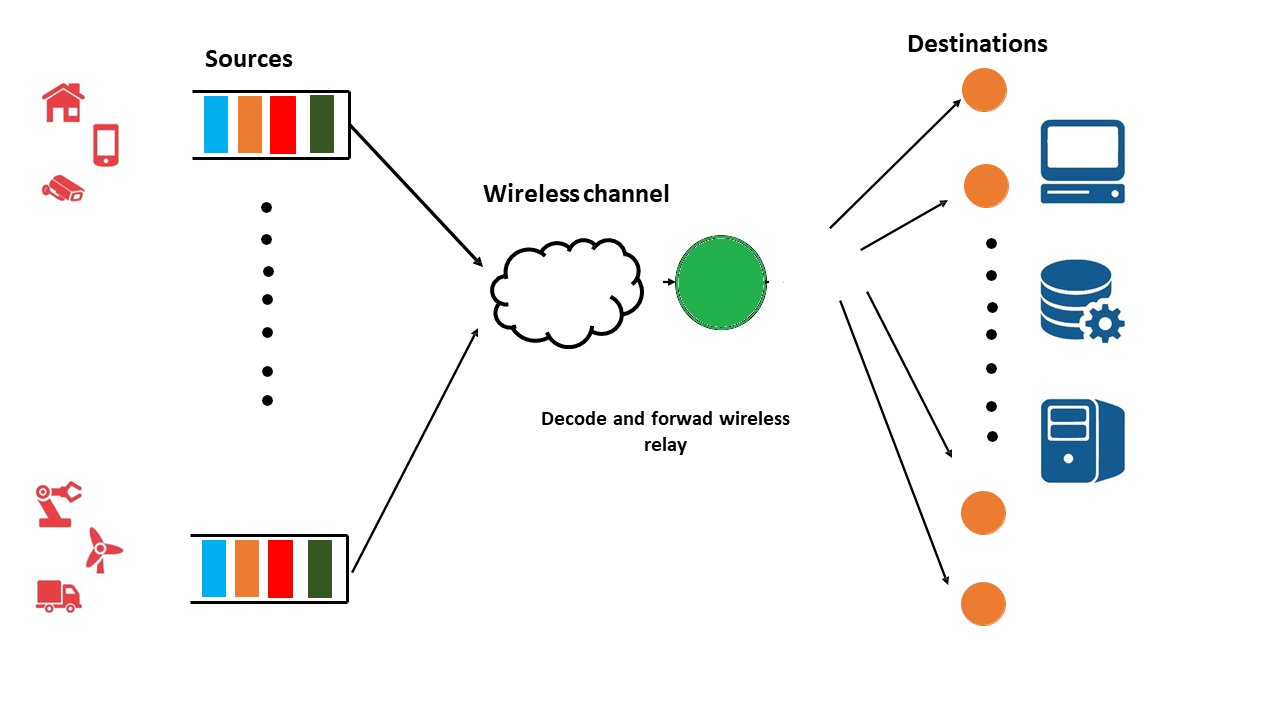Age of Information Model for wireless networks
Project description
agenet
A Python 3.8 implementation of a system model to estimate the average Age of Information (AoI) in an ultra-reliable low latency communication (URLLC) enabled wireless communication system with Slotted ALOHA scheme over the quasi-static Rayleigh block fading channels. A packet communication scheme is used to meet both the reliability and latency requirements of the proposed wireless network. By resorting to finite block length information theory, queuing theory, and stochastic processes, theoretical results can be obtained with this research software.
System model
The following figure illustrates the wireless communication system that is proposed in this application.
The diagram illustrates a wireless network that consists of multiple nodes. The transmission between each node and the relay is done using a transmission scheme similar to that of the Slotted ALOHA protocol, which is a popular random access method used in wireless communication systems.
However, the transmission between the relay and each destination uses dedicated communication channels, and as a result, no transmission scheme similar to ALOHA is employed for this part of the communication. This helps to reduce the possibility of collisions and improve the reliability of the communication.
Additionally, short packet communication is used for transmission. Since short packets are more susceptible to errors, a finite block length information theory is employed to calculate the block error rate. This allows for a more accurate estimation of the probability of errors occurring during transmission.
Features
The agenet package allows the user to study the Age of Information (AoI) in a slotted URLLC-enabled ALOHA network, which can be used as a basis for implementing mission-critical wireless communication applications. This application can be used as a study tool to analyze the age of information in slotted ALOHA networks with multiple users and short packet communications scenarios to maintain URLLC (ultra-reliable low-latency communication). In this application, various parameters such as power allocation, block length, packet size, number of nodes in the network, and activation probability of each node can be adjusted to analyze how the age of information varies.
The agenet package contains several functions that can be used to study the AoI in a slotted URLLC-enabled ALOHA network. These functions allow the user to:
-
Calculate the Signal-to-Noise Ratio (SNR) at each receiving node in the network, which is an important factor in determining the quality of the communication link;
-
Calculate the Block Error Rate (BER) for each destination in the network, which is an important metric for assessing the reliability of the network;
-
Calculate the theoretical AoI and simulate the AoI for a given network configuration, allowing the comparison of both measures to verify the accuracy of the simulation, as well as analyzing the performance of the network and assessing the impact of various parameters on the AoI;
-
Estimate the average AoI value for a given update generation time and receiving time, which is a useful metric for evaluating the performance of any network.
Additionally, a command-line script is included in the package that allows for easy experimentation with the model with default or user-defined parameters. The simulation can generate both theoretical and simulated values for various factors such as block lengths, power allocations, packet sizes, activation probabilities, and number of nodes in the network. These values can be presented in the form of tables using the following command.
$ ageprint
In addition to the tables, the simulation results can also be displayed as plots using the command:
$ ageplot
In both cases, adding the --help option displays the model's configurable parameters.
Requirements
The implementation requires Python 3.8+ to run. The following libraries are also required:
numpymatplotlibpandastabulateargparseitertoolsmathscipyrandom
How to install
Install from PyPI:
pip install agenet
Or directly from GitHub:
pip install git+https://github.com/cahthuranag/agenet.git#egg=agenet
Installing for development and/or improving the package
git clone https://github.com/cahthuranag/agenet.git
cd agenet
pip install -e .[dev]
This way, the package is installed in development mode. As a result, development dependencies are also installed.
Documentation
License
References
[1] Age of Information in an URLLC-enabled Decode-and-Forward Wireless Communication System
Project details
Release history Release notifications | RSS feed
Download files
Download the file for your platform. If you're not sure which to choose, learn more about installing packages.




















